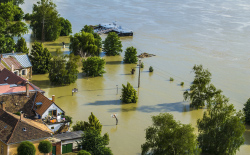Danube Watch 3/2021 - Danube Flood Risk Management Plan
DANUBE FLOOD RISK
MANAGEMENT PLAN
A Joint Vision For Sustainable Flood Risk Management In Our Shared Basin
Update 2021
by the ICPDR Secretariat
 What is the Danube Flood Risk Management Plan (DFRMP)?
What is the Danube Flood Risk Management Plan (DFRMP)?
The Danube Flood Risk Management Plan Update 2021 was created at the same time as the DRBMP Update 2021. While the latter is a document focusing on assessment and measures towards the achievement of “good status” in waters of the Danube River Basin, the latter is more specific in its focus on floods and related phenomena.
Floods are natural phenomena. They have shaped natural landscapes, created habitats, and supported ecosystems in floodplains, wetlands, and other lowlands since time immemorial. Floods are impossible to prevent entirely, although measures may be taken to reduce their frequency and the damage they cause.
Every six years, the ICPDR updates its DFRMP (as well as its DRBMP) focusing on the assessment and management of flood risks in the Danube River Basin. 2021 marks the first update to the DFRMP, the first version of which was published in 2015. The second update is due for 2027. This management plan offers rich and comprehensive information about flood risk management measures to be taken in the Danube River Basin. Flood Risk means the combination of the probability of a flood event and of the potential adverse consequences for human health, the environment, cultural heritage and economic activity associated with a flood event. Flood risk management plans have to define appropriate objectives and include measures to achieve these objectives. The following objectives of the DFRMP were agreed upon by the ICPDR in 2015, and continue to form the backbone of the updated plan as of 2021:
- Avoidance of new risks
- Reduction of existing risks
- Strengthening resilience
- Raising awareness
- Promoting the solidarity principle
These objectives focus on the reduction of potential adverse consequences of flooding for human health, the environment, cultural heritage and economic activity. They address all aspects of flood risk management focusing on prevention, protection and preparedness, including flood forecasts and early warning systems and taking into account the characteristics of the Danube River Basin.
Floods Directive
The ICPDR acts as a platform for the implementation of the EU Floods Directive (FD), key legislation on the assessment and management of flood risks. Its full name is Directive 2007/60/EC of the European Parliament and of the Council of 23 October 2007 on the assessment and management of flood risks. The FD is connected to the Water Framework Directive (Directive 2000/60/EC), stating that measures shall take into account the relevant environmental objectives in the WFD. The ICPDR acts as a joint platform for the implementation of the Danube River Protection Convention, our founding legal document, along with the European Union’s Water Framework Directive (WFD) and Floods Directive (FD). The benefits of these important pieces of legislation are for the entire basin and its people.

Our Focus In 2021
The measures described in the DFRMP focus particularly on:
- Prevention For example, this could mean preventing damage caused by floods by avoiding construction of houses and industries in flood-prone areas, or by adapting future developments to the risk of flooding.
- Protection For example, this could mean taking measures to reduce the impact of floods in a specific location, including the restoration of floodplains and wetlands.
- Preparedness This could include awareness-raising activities and the provision of practical information to the public on what to do in the event of flooding, for example, by making flood risk maps available.
Objectives
As stipulated in the EU Floods Directive (FD), appropriate objectives for the management of flood risks should be established focusing on the reduction of potential adverse consequences of flooding for human health, the environment, cultural heritage and economic activity, as well as other initiatives reducing the likelihood of flooding. The following objectives of the DFRMP for the Danube River Basin District were agreed upon by the ICPDR in 2015 – and continue to form the backbone of the plan’s 2021 update.

Avoid New Risks
New buildings in areas of potential flood risks present an easily avoidable risk. Inappropriate spatial planning as well as urban, rural and industrial development and construction in the areas of potential significant flood risk will lead to future increases in damages, losses and casualties. All such activities shall be planned and carried out without having any impacts on increasing the risk of flooding.
Promoting the solidarity principle The solidarity principle is very important in the context of flood risk management. In the light of it, countries should be encouraged to seek a fair sharing of responsibilities, when measures are jointly decided for common benefit. The FD explicitly stipulates this principle with regard to EU members, and the DFRMP extends it to all Danubian countries.
What is the solidarity principle? The ICPDR is fully aware of the importance of applying the solidarity principle; one should not pass-on water management problems from one region to another. That is why the ICPDR agreed that measures with downstream effects shall have key priority at the basin-wide level. According to the DFRMP: “Countries shall not apply measures which, by their extent and impact, significantly increase flood risks in the countries neighbouring upstream or downstream. Countries should take all possible steps not to export the flood problems to their neighbours.”
Reduction of Existing Risks
 The purpose of the FD is to establish a framework for the assessment and management of flood risks, aiming at the reduction of the adverse consequences associated with floods. All FD implementation steps in the Danube River Basin have been accomplished following this principle, including Preliminary Flood Risk Assessment (PFRA), along with the development of both flood maps and of the Danube Flood Risk Management Plan (DFRMP).
The purpose of the FD is to establish a framework for the assessment and management of flood risks, aiming at the reduction of the adverse consequences associated with floods. All FD implementation steps in the Danube River Basin have been accomplished following this principle, including Preliminary Flood Risk Assessment (PFRA), along with the development of both flood maps and of the Danube Flood Risk Management Plan (DFRMP).
Strengthening Resilience
 To improve its resilience against flooding, society must have an adequate emergency response both during and immediately following flooding events. This helps to limit adverse effects and assists in recovery to regain a standard of living comparable to – or perhaps even better than – how it was prior to the flooding event.
To improve its resilience against flooding, society must have an adequate emergency response both during and immediately following flooding events. This helps to limit adverse effects and assists in recovery to regain a standard of living comparable to – or perhaps even better than – how it was prior to the flooding event.
Raising Awareness
 Public participation in decision-making is a cornerstone of successful implementation of integrated and comprehensive management plans, both to improve the quality and the implementation of the decisions, and to give the public the opportunity to express its concerns and to enable authorities to take due account of such concerns.
Public participation in decision-making is a cornerstone of successful implementation of integrated and comprehensive management plans, both to improve the quality and the implementation of the decisions, and to give the public the opportunity to express its concerns and to enable authorities to take due account of such concerns.






